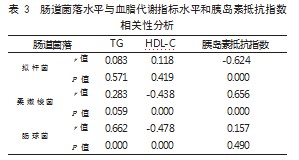【摘要】 目的:分析 2 型糖尿病(T2DM)患者肠道菌落水平与血脂代谢水平和胰岛素抵抗指数的相关性。方法: 选取 2020 年 1 - 12 月该院收治的 126 例 T2DM 患者作为观察组,选取同期于该院进行常规体检的 100 名健康者作为对照组,进行病例对照研究。根据肠道菌落 情况又将观察组分为肠道菌落异常组( n=52.粪便培养中计算 B/E 值 <1)和肠道菌落正常组( n=74. B/E 值≥ 1) 。测定并比较三组肠道菌 落水平、血脂代谢指标 [ 三酰甘油(TC) 、总胆固醇(TG) 、高密度脂蛋白胆固醇(HDL-C) 、低密度脂蛋白胆固醇(LDL-C) ] 水平和胰 岛素抵抗指数水平,并采用 Pearson 相关性分析,分析 T2DM 患者肠道菌落水平与血脂代谢指标水平和胰岛素抵抗指数的相关性。结果: 肠 道菌落异常组拟杆菌水平低于肠道菌落正常组和对照组,且肠道菌落正常组低于对照组;肠道菌落异常组肠球菌、柔嫩梭菌水平高于肠道 菌落正常组和对照组,且肠道菌落正常组高于对照组,差异均有统计学意义( P<0.05) 。肠道菌落异常组胰岛素抵抗指数水平、TC 水平、 TG 水平、LDL-C 水平均高于肠道菌落正常组和对照组,且肠道菌落正常组高于对照组,差异均有统计学意义( P<0.05) ;肠道菌落异常组 HDL-C 水平低于肠道菌落正常组和对照组,且肠道菌落正常组低于对照组,差异均有统计学意义( P<0.05)。Pearson 相关性分析结果显示, T2DM 患者肠道拟杆菌水平与胰岛素抵抗指数呈负相关( r<0.P<0.05);T2DM 患者肠道柔嫩梭菌水平与 HDL-C 水平呈负相关( r<0.P<0.05), 与胰岛素抵抗指数呈正相关( r>0.P<0.05); T2DM 患者肠道肠球菌水平与 TG 水平呈正相关( r>0.P<0.05), 与 HDL-C 水平呈负相关( r<0. P<0.05)。 结论: T2DM 患者肠道菌落水平异常与血脂代谢水平和胰岛素抵抗指数存在相关性。
【关键词】 2 型糖尿病;肠道菌落失常;血脂代谢;胰岛素抵抗
Correlations of intestinal flora levels with blood lipid metabolism levels and insulin resistance index in patients with type 2 diabetes mellitus
XU Min, DANG Shaohua, XIN Ning
(The Third People’s Hospital of Zhengzhou, Zhengzhou 450000 Henan, China)
【Abstract】 Objective: To observe correlations of intestinal flora levels with blood lipid metabolism levels and insulin resistance index in patients with type 2 diabetes mellitus (T2DM). Methods: 126 T2DM patients admitted to our hospital from January to December 2020 were selected as observation group, and 100 healthy individuals who underwent routine physical examination in our hospital during the same period were selected as control group. They were included in a case-control study. According to the intestinal flora conditions, the observation group was subdivided into abnormal intestinal flora group (n=52. B/E value calculated in fecal culture <1) and normal intestinal flora group (n=74. B/E value ≥ 1). The levels of intestinal flora, the blood lipid metabolism indexes levels [triacylglycerol (TC), total cholesterol (TG), high-density lipoprotein cholesterol (HDL-C), and low-density lipoprotein cholesterol (LDL-C)], and the insulin resistance index levels were measured and compared among the three groups. Pearson correlation analysis was used to analyze the correlations among the intestinal flora levels and the blood lipid metabolism levels and the insulin resistance index in the patients with T2DM. Results: The level of Bacteroides in the abnormal intestinal flora group was lower than those in the normal intestinal flora group and the control group, and that of the normal intestinal flora group was lower than that of the control group; the levels of Enterococcus and Clostridium leptum in the abnormal intestinal flora group was higher than those in the normal intestinal flora group and the control group, and that of the normal intestinal flora group was higher than that of the control group; and the differences were statistically significant (P<0.05). The levels of insulin resistance index, TC, TG and LDL-C in the abnormal intestinal flora group were higher than those in the normal intestinal flora group and the control group, those of the normal intestinal flora group were higher than those of the control group, and the differences were statistically significant ( P<0.05). The HDL-C level in the abnormal intestinal flora group was lower than those in the normal intestinal flora group and the control group, that of the normal intestinal flora group was lower than that of the control group, and the differences were statistically significant (P<0.05). The Pearson correlation analysis showed that the level of intestinal Bacteroides in the patients with T2DM was negatively correlated with the insulin resistance index (r<0. P<0.05); the level of intestinal Clostridium leptum was negatively correlated with the HDL-C level (r<0. P<0.05) and positively correlated with the insulin resistance index (r>0. P<0.05); the Enterococcus level was positively correlated with the TG level (r>0. P<0.05), and was negatively correlated with the HDL-C level (r<0. P<0.05). Conclusions: Abnormal intestinal flora levels are correlated with the blood lipid metabolism levels and the insulin resistance index.
【Key words】 Type 2 diabetes mellitus; Intestinal flora disturbance; Blood lipid metabolism; Insulin resistance
2 型糖尿病(T2DM)以代谢异常为特征,患 者多以药物控制血糖水平为主,防止病情进一步发 展 [1]。T2DM 发病与胰岛 β 细胞功能障碍、胰岛 素抵抗关系密切 [2] 。而肠道菌落异常可导致代谢异 常, 促进 T2DM 进展 [3-4] 。本文分析 T2DM 患者肠 道菌落水平与血脂代谢水平和胰岛素抵抗指数的相 关性。

1 资料与方法
1.1 一般资料 选取 2020 年 1 - 12 月本院收治 的 126 例 T2DM 患者作为观察组,选取同期于本院 进行常规体检的 100 名健康者作为对照组,进行病 例对照研究。纳入标准: 符合 T2DM 诊断标准 [5]; 观察组患者有降糖药物治疗史;无其他急慢性疾病。 排除标准:合并消化道疾病; 1 型糖尿病;近期有 胃肠手术史;存在视听障碍,无法配合研究。患者 及家属对本研究内容了解且自愿签署知情同意书, 研究经本院伦理委员会审批通过。根据肠道菌落情 况又将观察组分为肠道菌落异常组( n=52. 粪便培 养中计算 B/E 值 <1)和肠道菌落正常组( n=74.B/E 值≥ 1) 。肠道菌落异常组:男 31 例,女 21 例;年 龄 35~77 岁,平均(59.24±6.57)岁。肠道菌落正常组: 男 44 例,女 30 例;年龄 34~78 岁,平均(59.57±6.89) 岁。对照组: 男 59 名, 女 41 名; 年龄 33~76 岁, 平 均(58.69±6.35) 岁。三组一般资料比较, 差异无统 计学意义( P>0.05),有可比性。
1.2 方法 测定三组肠道菌落水平、血脂代谢指 标水平和胰岛素抵抗指数。
1.2.1 肠道菌落水平测定 所有入选者均采集粪便 标本, 置入密闭储存盒保存, 并放入 -80 ℃冰箱待 测,粪便细菌总 DNA 使用粪便 DNA 提取试剂盒提 取,应用菌属 16rRNA v3 序列特异性引物进行实时 荧光定量 PCR 分析, 使用细菌拷贝数的常用对数 /g 表示最终结果。
1.2.2 血脂代谢指标水平测定 于空腹 8 h 后采 血,取 5 mL 外周静脉血,使用抗凝管装取,以 3500 r/min 速度离心,15 min 后分离血清, 离心半径 8 cm,用于检测三酰甘油(TC)、总胆固醇(TG)、 高密度脂蛋白胆固醇(HDL-C) 、低密度脂蛋白胆 固醇(LDL-C), 使用日立 7179 全自动化分析仪 检测,为配套试剂,所有检测步骤需严格按照产品 说明书进行。
1.2.3 胰岛素抵抗指数 胰岛素抵抗指数 =[ 空腹 胰岛素(μU/mL)× 空腹血糖(mmol/L)]/22.5.
1.3 观察指标 比较三组(肠道菌落失常组、肠 道菌落正常组、对照组)目标菌属水平、血脂代谢 指标水平及胰岛素抵抗指数,并采用 Pearson 相关 性分析,分析肠道菌落水平与血脂代谢水平和胰岛 素抵抗指数的相关性。
1.4 统计学方法 应用 SPSS 22.0 软件进行统计学 分析,计量资料以( ±s )表示,三组间比较采用 方差分析,进一步两两比较采用 LSD 法,计数资 料以率(%)表示,采用 χ2 检验,相关性分析采用 Pearson 分析,以 P<0.05 为差异有统计学意义。
2 结果
2.1 三组肠道菌落水平比较 肠道菌落异常组拟 杆菌水平低于肠道菌落正常组和对照组,且肠道菌 落正常组低于对照组;肠道菌落异常组肠球菌、柔 嫩梭菌水平均高于肠道菌落正常组和对照组,且肠 道菌落正常组高于对照组,差异均有统计学意义 ( P<0.05) ;三组大肠杆菌、双歧杆菌、普氏菌、 乳酸杆菌、球形梭菌水平比较,差异无统计学意义 ( P>0.05)。见表 1.
2.2 三组血脂代谢指标水平和胰岛素抵抗指数比 较 肠道菌落异常组胰岛素抵抗指数、TC 水平、TG 水平、LDL-C 水平均高于肠道菌落正常组和对照组, 且肠道菌落正常组高于对照组,差异均有统计学意 义( P<0.05) ;肠道菌落异常组 HDL-C 水平低于肠 道菌落正常组和对照组,且肠道菌落正常组低于对 照组,差异均有统计学意义( P<0.05)。见表 2.
2.3 肠道菌落水平与血脂代谢指标水平和胰岛素 抵抗指数相关性分析 Pearson 相关性分析结果显 示, T2DM 患者肠道拟杆菌水平与胰岛素抵抗指数呈负相关( r<0. P<0.05);T2DM 患者肠道柔嫩梭 菌水平与 HDL-C 水平呈负相关( r<0. P<0.05), 与 胰 岛 素 抵 抗 指 数 呈 正 相 关( r>0. P<0.05); T2DM 患者肠道肠球菌水平与 TG 水平呈正相关 ( r>0. P<0.05), 与 HDL-C 水平呈负相关( r<0. P<0.05)。见表 3.



3 讨论
T2DM 患者长期处于高血糖水平状态,可损害 全身多个器官, 严重威胁患者健康 [6], 患者经降糖、 胰岛素等治疗并不能完全阻止疾病进展 [7] 。已知肠 道菌落与脂类代谢异常、肥胖有一定相关性 [8] 。正 常情况下致病菌与有益菌处于平衡状态,一旦平衡 遭到破坏,代谢紊乱,将会导致疾病 [9] 。不同的肠 道菌种具有不同作用,肠道厚壁杆菌为含量最高的 优势菌,柔嫩梭菌、肠球菌均属于此类菌属,拟杆 菌为第二大优势菌 [10]。肠球菌、柔嫩梭菌会产生大 量的丁酸盐细菌,宿主无法直接吸收丁酸,随着肠 道厚壁杆菌不断增加,会导致食物能量的吸收能力 提高, 易出现肥胖 [10]。拟杆菌则在类固醇、胆汁酸、 多糖的代谢中均有参与,一旦肠道菌落失常将会导 致机体代谢异常,诱发疾病 [11]。

本研究结果显示,肠道菌落异常组拟杆菌水平 低于肠道菌落正常组和对照组,且肠道菌落正常组 低于对照组;肠道菌落异常组肠球菌、柔嫩梭菌水 平均高于肠道菌落正常组和对照组,且肠道菌落正 常组高于对照组;肠道菌落异常组胰岛素抵抗指数、 TC 水平、TG 水平、LDL-C 水平均高于肠道菌落正 常组和对照组,且肠道菌落正常组高于对照组;肠 道菌落异常组 HDL-C 水平低于肠道菌落正常组和对照组,且肠道菌落正常组低于对照组; Pearson 相关性分析结果显示, T2DM 患者肠道拟杆菌水平 与胰岛素抵抗指数呈负相关; T2DM 患者肠道柔嫩 梭菌水平与 HDL-C 水平呈负相关,与胰岛素抵抗 指数呈正相关; T2DM 患者肠道肠球菌水平与 TG 水平呈正相关,与 HDL-C 水平呈负相关。提示 T2DM 患者存在肠道菌落异常,其水平与血脂代谢 指标水平和胰岛素抵抗指数存在相关性。
综上所述, T2DM 患者肠道菌落水平异常与血 脂代谢水平和胰岛素抵抗指数存在相关性。
参考文献
[1] 贺菲菲,宋民喜,徐琳,等 . 利拉鲁肽联合基础胰岛素对初诊 2 型糖尿病合并肥胖患者血糖控制、血脂代谢及氧化应激 的影响 [J]. 海南医学院学报,2018.24(2):173-176.
[2] 胡淑国,宋国桥,王丽慧,等 . 2 型糖尿病患者骨骼肌脂肪酸代谢对胰岛素敏感性的影响 [J]. 中国医师杂志, 2018. 20(3): 435-437.
[3] 陈诚,雷涛,沙雯君,等 . 双歧杆菌三联活菌胶囊辅助治疗 2型糖尿病对患者肠道菌群及血糖的影响 [J]. 海南医学, 2020. 31(18):2330-2333.
[4] 钱宇洁,郭良清 . 浅析肠道菌群与 2 型糖尿病及冠心病的关系 [J]. 中国微生态学杂志,2020.32(11):1346-1348.
[5] 中华医学会,中华医学会杂志社,中华医学会全科医学分会,等 . 2 型糖尿病基层诊疗指南(实践版 ·2019) [J]. 中华全科 医师杂志,2019.18(9):810-818.
[6] 曹雯,孙洪平,范尧夫,等 . 2 型糖尿病患者血尿酸水平与胰岛素抵抗的相关性分析 [J]. 国际内分泌代谢杂志, 2020. 40 (3):145-149.
[7] 许忆峰,郭庆军,王超群,等 . 2 型糖尿病患者颈腰围与胰岛素抵抗及代谢综合征关系比较分析 [J]. 医学研究杂志, 2018. 47(10):36-40.
[8] 陈茜,薛勇,宋晓峰,等 . 糖尿病及糖尿病心血管并发症患者肠道菌群的特征 [J]. 微生物学报,2019.59(9):1660-1673.
[9] 刘枘岢,陈毅光,李雯翀,等 . 2 型糖尿病患者肠道菌群的变化及其与代谢指标的关系 [J]. 实用医学杂志, 2019. 35(20): 3208-3213.
[10] 蔡辉耀,杨鑫娜,陈丽君,等 . 2 型糖尿病患者血清 miR-21-5p 与肠道菌群失调及炎症状态的关系研究 [J]. 中国病原生物 学杂志,2020.15(11):110-113.
[11] 郭哲, 宁金月, 王玉沙 . 2 型糖尿病患者 BMI 与 HbAlc、胰岛素抵抗及肾损害指标的相关性分析 [J]. 川北医学院学报, 2020.35(2):297-300.本次研究将我院于 2016 年 6 月至 2017 ... 详细>>
如何设计有效的环境治理政策, 是学术界和政策... 详细>>
